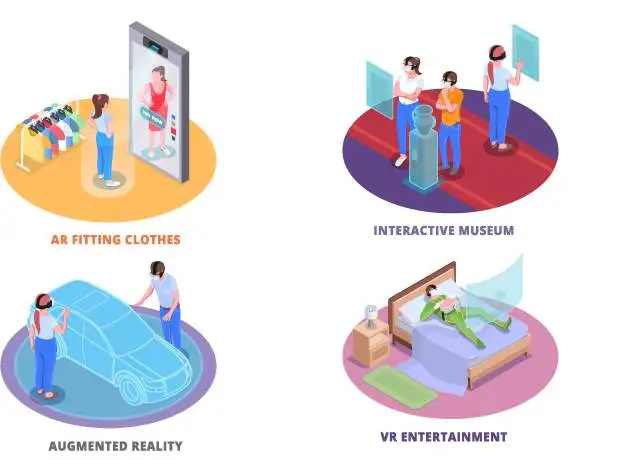The eCommerce sector has always been developing continuously to give customers better and more immersive shopping experiences. Augmented reality (AR) is one of the latest technologies which transforms the eCommerce sector. AR blends the virtual and physical worlds by overlaying digital content in the real environment. Through this, both businesses and consumers get various advantages.
Here, we will mention what augmented reality is, the types of augmented reality, and ways that AR is changing eCommerce. And also its benefits to businesses.
What is Augmented Reality (AR)?
There are two technologies as AR and VR technology. Augmented Reality is used to display digital content overlaid in the real world in real-time. But Virtual Reality (VR) is a whole virtual world with digital elements and VR is not real-time. such as videos, photographs, 3D models, or animations can be enhanced by AR. This will improve the user experience and also how the user interacts. How fascinating is that?
AR gives up new possibilities for immersive experiences that blur the barriers between the physical and digital worlds via devices such as smartphones, tablets, smart glasses, and headsets. With AR creations, the ordinary becomes extraordinary as digital features blend effortlessly with the real world, offering endless opportunities for innovation and transformation in various industries, including the dynamic world of eCommerce.
Types of Augmented Reality
Different kinds of AR are generally used in eCommerce, including:
-
Marker-based AR
In this kind of augmented reality, a physical marker, like an image or a QR code, is used as a trigger to add digital content to the physical environment. When an AR-enabled device detects the marker, digital material is generated on top of the marker, creating an interactive experience.
-
Markerless AR
Markerless AR, which is also known as location-based AR, does not require a physical marker. Instead, it detects the user’s location and orientation via the device’s various sensors and then overlays digital material onto the actual environment in accordance. This type of augmented reality is often used for location-based experiences like navigation, tourism, and gaming.
-
Object-based AR
Object-based AR involves recognising and monitoring real-world items, such as products, furniture, or automobiles, and superimposing digital material on top of them. This sort of augmented reality is often utilised in eCommerce for virtual try-on experiences, in which customers may virtually try on clothing, accessories, or makeup, or visualise how furniture or home decor might look in their area.
3 Ways that Augmented Reality will Transform eCommerce: Augmented Reality Marketing
 https://www.freepik.com/free-vector/virtual-augmented-reality_14741335.htm
https://www.freepik.com/free-vector/virtual-augmented-reality_14741335.htm
Augmented Reality has the potential to transform the eCommerce sector in a variety of ways. Basically in these ways.
-
Enhanced Product Visualisation
One of the most challenging aspects of online purchasing is the lack of real touch and feel. AR covers this issue by enhancing product visualisation, allowing customers to view how things would seem or fit in their environment. Customers, for example, can virtually try on products, examine how the furniture fits in their room, or visualise how home design might look in their environment using AR. This improves the shopping experience and allows customers to make better-educated purchases, lowering the risk of returns and enhancing customer happiness.
-
Personalised Shopping Experiences
By personalising product recommendations and offers based on particular customer interests, behaviours, and purchase history, AR may enable personalised shopping experiences. Customers, for example, can virtually try on makeup to find the appropriate shade for their skin tone, or customise and visualise products with various options and variants using AR. This level of personalisation results in a more engaging and immersive purchasing experience, which leads to increased consumer engagement, loyalty, and repeat purchases.
-
Virtual Try-Before-You-Buy
AR-enabled virtual try-before-you-buy experiences can greatly minimise the uncertainty and risk of online purchases. Before making a purchase, customers can virtually try on things or see how they might seem in their settings. This allows clients to make more confident purchasing decisions while lowering the possibility of returns, which may be costly for eCommerce enterprises. Customers, for example, can virtually try on clothes, accessories, or makeup, check how the furniture fits in their room, or envisage how home decor might look in their area using AR. This not only improves the shopping experience but also saves customers time and effort, resulting in enhanced customer satisfaction and loyalty.
Future of AR eCommerce (Benefits)
Rather than Augmented reality in software development. The future of augmented reality in eCommerce is positive, with various advantages for businesses.
-
Increased Sales and Conversion Rates
AR may greatly improve sales and conversion rates by delivering enhanced product visualisation, personalised shopping experiences, and virtual try-before-you-buy experiences. Customers are more inclined to purchase things when they see how they might appear or fit in their setting, and when the shopping experience is personalised and interesting. According to studies, firms that integrate augmented reality in their eCommerce operations report a rise in sales and conversion rates.
-
Reduced Returns and Improved Customer Satisfaction
AR can help reduce return rates by allowing buyers to digitally try on things or see how they would look in their settings before purchasing. This eliminates the uncertainty and danger of online purchases, resulting in increased customer happiness and loyalty. Reduced returns also save money for eCommerce organisations, as processing refunds may be time-consuming and expensive.
-
Competitive Advantage
Businesses that include augmented reality in their eCommerce tactics have a competitive advantage over those that do not. AR offers a distinct and immersive shopping experience that distinguishes businesses from their competitors. Businesses can attract more customers, boost customer engagement and loyalty, and stay ahead of the competition by providing creative and compelling AR experiences.
-
Cost Savings
AR can also help firms save money in a variety of ways. Businesses, for example, can decrease the requirement for physical inventory and in-store samples by allowing customers to virtually try on things. Furthermore, augmented reality (AR) helps streamline the product customisation process, lowering the expenses associated with generating physical prototypes or samples. Customers can digitally try on things or visualise them in their environment without needing a physical store, which reduces the demand for physical showrooms or retail locations.
Outline
Augmented reality has the potential to shake up the future of the eCommerce sector through boosted product visualisation, personalised shopping experiences, and virtual try-before-you-buy experiences. Businesses that include augmented reality in their eCommerce operations should expect better sales and conversion rates, lower returns, a competitive advantage, and cost savings.
As technology advances, the potential of AR in eCommerce is projected to rise, creating new options for businesses to improve their customers’ buying experiences.
Don’t pass up the advantages of Augmented Reality in eCommerce! Subscribe to Sanmark Solution‘s newsletter to stay up to date on the newest trends and breakthroughs. Utilise AR to gain advance over the competition to its fullest in your eCommerce business. Subscribe now to stay up to date!
Feature image credit goes to: https://www.freepik.com/free-vector/augmented-reality_2317766.htm

Leave A Comment